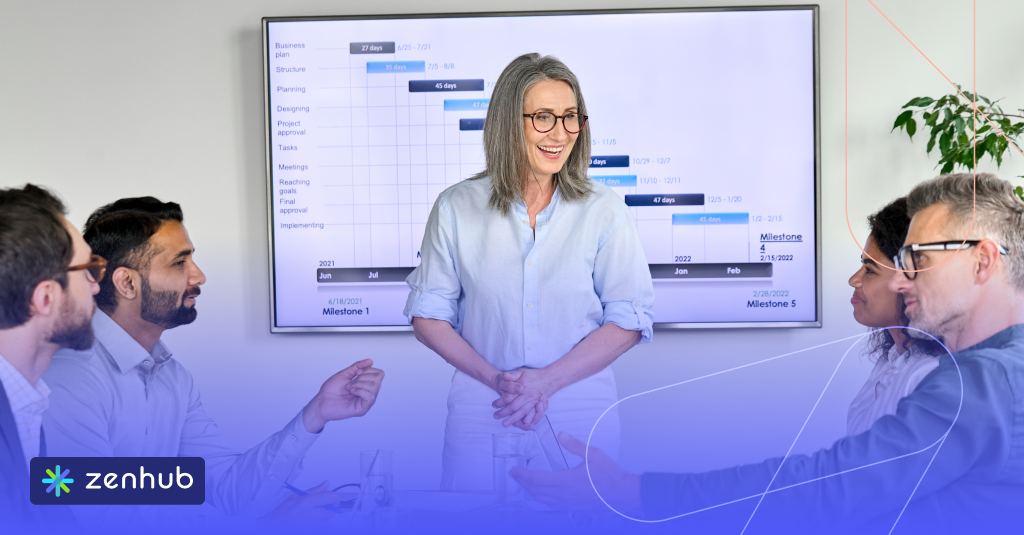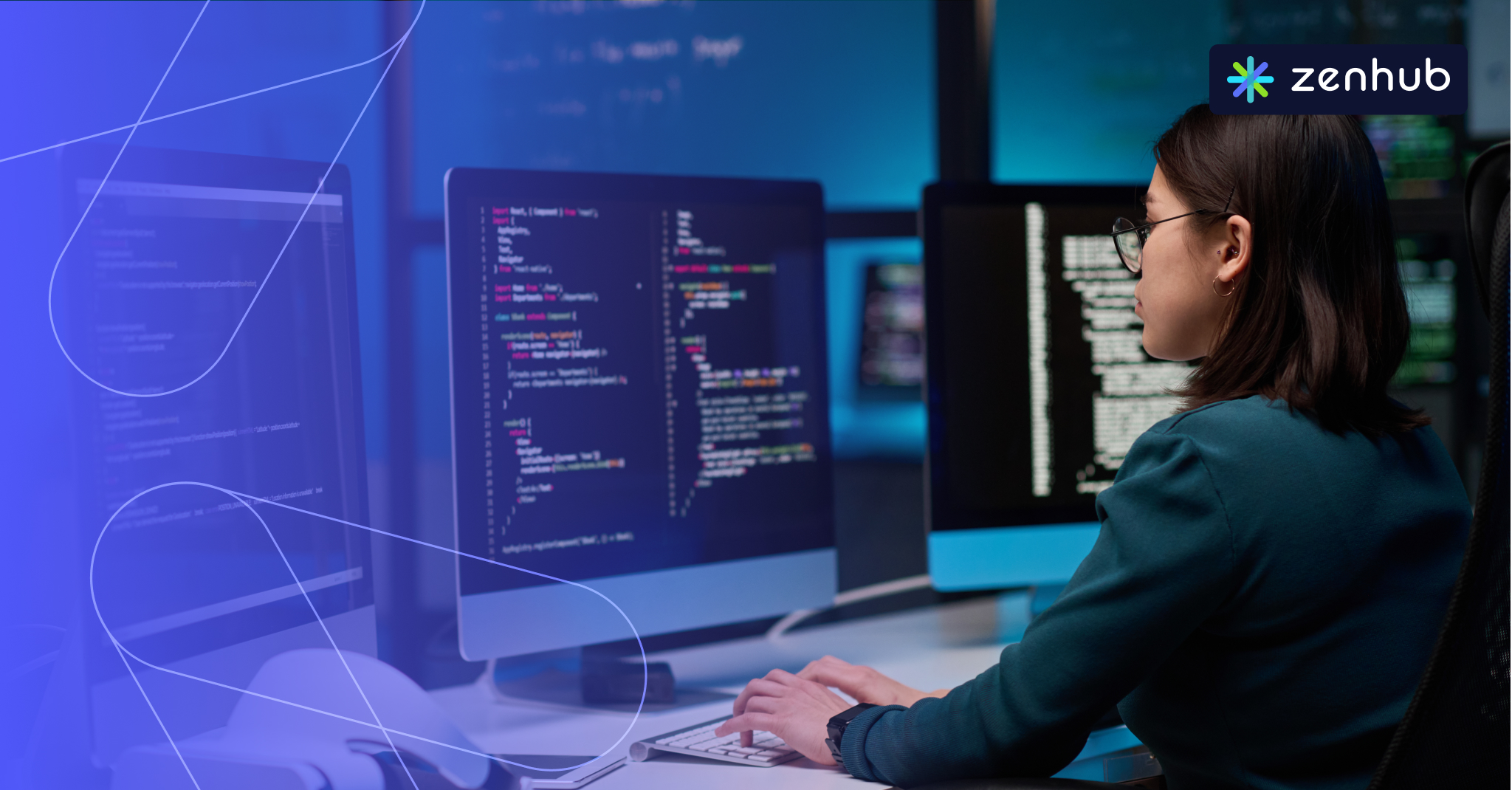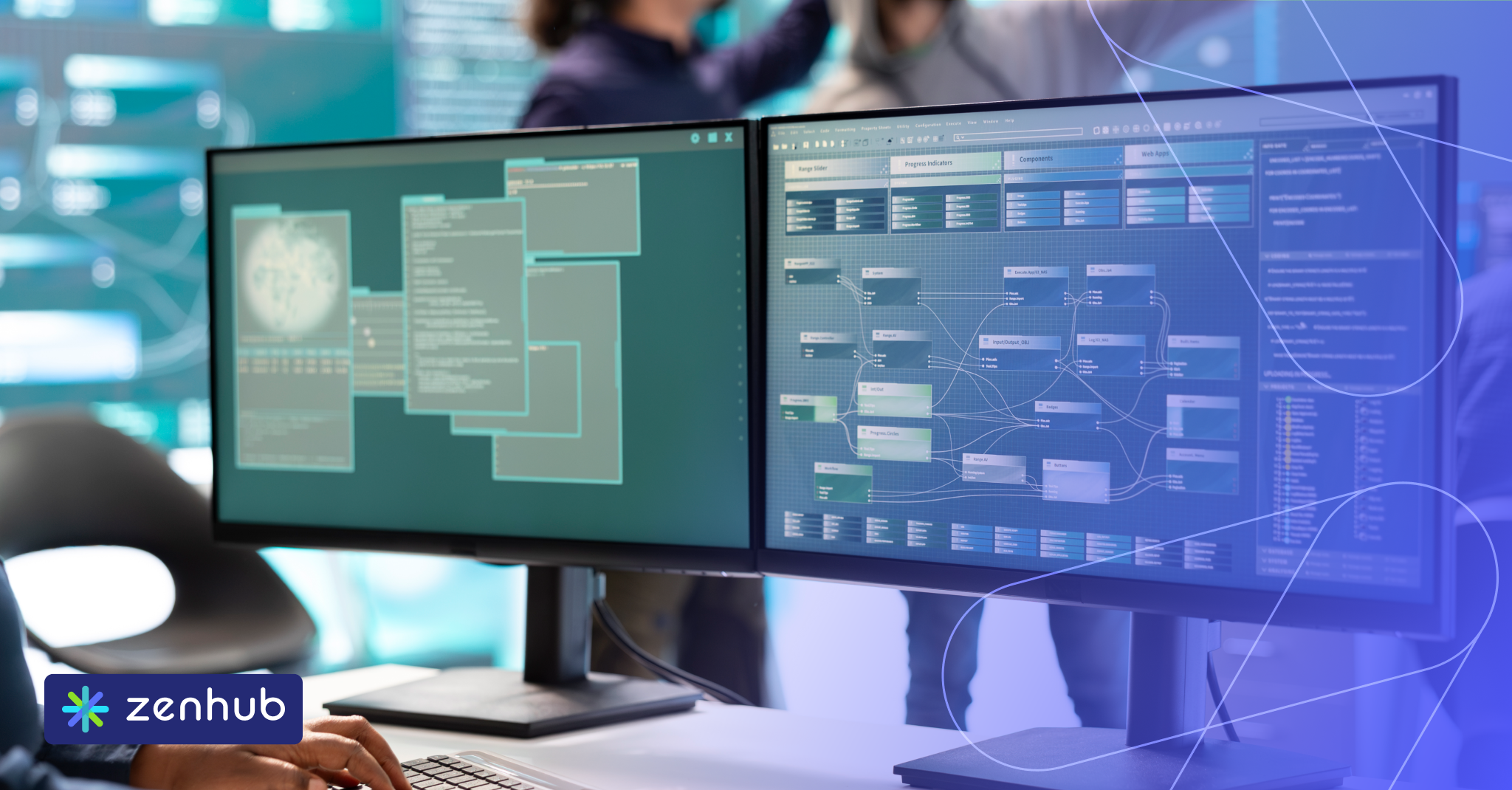Browse topics
AI teams move quickly, but many still lose valuable time each week to inefficient processes, constant context switching, and tools that don’t match how they work. For a mid-sized team, that can mean hundreds of thousands of dollars lost each year in wasted engineering effort.
According to recent industry research, AI software teams lose 23 hours per week to inefficient processes, context switching, and inadequate tooling, representing nearly $380,000 in wasted engineering resources annually for mid-sized teams.
The statistics tell a compelling story: 80% of AI teams now rely on specialized project management tools that cater to their unique workflows, and those who do report 42% faster time-to-market for machine learning models. As AI becomes increasingly central to business operations, having the right systems isn't just about efficiency but competitive survival.
This guide looks at the tools that support the way AI teams build software today, focusing on GitHub-native options and agile-friendly features.
Why AI Software Teams Need Specialized Project Management
Traditional project management tools like general-purpose agile boards or basic task trackers are inadequate for AI teams working with massive datasets, complex model training, and rapid release cycles. This gap creates substantial problems that directly impact delivery timelines and engineering morale.
Unique Workflow Challenges (Data Sets, Model Training, GPU Queues)
AI teams face three distinctive challenges that standard PM tools cannot adequately address:
- Enormous datasets: AI projects frequently involve terabytes of training data across distributed storage systems. Standard PM tools cannot link tasks directly to these datasets, creating visibility gaps in the development cycle. For example, a computer vision team working on autonomous driving might need to track 500,000 labeled road images across multiple projects—a scale that overwhelms conventional task management.
- Iterative model training: ML workflows require tracking multiple experiment branches simultaneously, each with different hyperparameters, data subsets, and validation metrics. Teams resort to scattered spreadsheets without specialized tooling, losing critical historical context.
- GPU resource contention: AI teams constantly battle for scarce compute resources. GPU queues—ordered waitlists that allocate graphics processing unit resources to jobs, ensuring fair access and preventing resource contention—are a daily reality that mainstream PM tools simply weren't designed to accommodate.
Consider a scenario where a vision-ML team has a critical model improvement scheduled for deployment. Still, their training job sits in a GPU queue for 8 hours behind lower-priority tasks. Without integrated visibility between the project management system and compute resource allocation, managers remain blind to these bottlenecks until deadlines are missed.
Drawbacks of Generic PM Apps for Code-Heavy Teams
Generic project management solutions create substantial friction for AI engineering teams in four key areas:
- Context switching costs: Engineers lose 4.2 hours weekly toggling between GitHub and external PM tools, according to our research. Each context switch takes 23 minutes to regain complete focus, devastating productivity.
- Shallow repository integration: Most PM tools offer basic GitHub connections but lack the deep integration for AI teams. Critical activities like PR reviews, branch management, and complex code changes remain disconnected from the project tracking system.
- Limited automation capabilities: General PM tools lack the specific automation needed for ML workflows, forcing manual status updates and repetitive data entry.
- Inadequate security controls: AI projects often involve proprietary algorithms and sensitive data, requiring stringent access controls that generic tools rarely provide.
Benefits of AI-Powered, GitHub-Connected Tools
GitHub-native project management tools built specifically for AI teams deliver substantial advantages:
- Elimination of context switching: Engineers stay within their GitHub environment, maintaining flow state and increasing productivity by 27% on average.
- Real-time visibility: Project managers gain immediate insight into pull-request status, deployment health, and actual development progress without manual updates.
- Intelligent automation: AI-powered tools can automatically triage issues, generate sprint summaries, and suggest appropriate labels, reducing administrative overhead by up to 15 hours per sprint.
- Stronger governance: Teams achieve better compliance with development standards through automated checks and validations integrated with their GitHub workflow.
One ML team lead at a Fortune 500 company reported: "Moving to a GitHub-native project management system reduced our model release cycle time by 40% and virtually eliminated our weekly status meetings—the tools now provide that visibility automatically."
How We Scored and Selected the Top Tools
Our evaluation methodology prioritizes the specific requirements of AI engineering teams, with a transparent scoring system based on quantifiable metrics and user feedback.
Evaluation Criteria (Integration, AI Capabilities, Security)
We evaluated each tool against five essential criteria:
- GitHub/DevOps Integration Depth (30%): How seamlessly the tool connects with GitHub repositories, actions, pull requests, and code reviews.
- AI Feature Capabilities (25%): The degree to which the tool provides specialized functionality for managing AI/ML workflows, experiment tracking, and resource allocation.
- Security & Compliance (20%): SOC 2 compliance (an auditing standard verifying secure data management and privacy controls), data encryption, access controls, and audit logging capabilities.
- User Experience & Onboarding (15%): The intuitiveness of the interface, the learning curve, and the quality of the documentation.
- Total Cost of Ownership (10%): Pricing structure, scaling costs, and additional resources required for full implementation.
Scoring Methodology at a Glance
Our assessment combined quantitative and qualitative inputs:
- 200+ hours of hands-on testing across seven evaluation teams
- 157 customer interviews with AI engineering leaders
- Analysis of 3,245 G2 and Capterra reviews
- Internal benchmarking against 14 standardized workflow scenarios
Each tool received a weighted score based on these criteria, with additional consideration given to unique strengths that might benefit specific team types or project structures.
Quick Comparison Table
The 7 Best Project Management Tools for AI Software Teams
1. Zenhub — GitHub-Native Agile with AI Insights
Zenhub delivers the most seamless GitHub integration with specialized AI capabilities designed for software teams handling complex machine learning workflows.
- Direct GitHub embedding means engineers never leave their development environment. They have full project visibility inside GitHub's interface and comprehensive two-way synchronization.
- Planning Poker and AI-assisted estimation help teams forecast complex ML development timelines more accurately.
- Automated sprint management intelligently groups related tasks and dependencies across repositories.
- Pulse AI summaries provide automated sprint retrospectives with key metrics, blockers, and accomplishments extracted directly from GitHub activity.
Dapper Labs, creators of NBA Top Shot and Flow blockchain, cut their ML model deployment cycle time by 32% after adopting Zenhub, primarily by eliminating status meetings and manual updates.
The early-access GPT-4 features offer auto-generated acceptance criteria for model training tasks and intelligent dependency detection for complex ML workflows.
Join the world's most productive software teams by trying Zenhub free for 14 days.
2. Jira Software + Atlassian Intelligence
Jira Software with Atlassian Intelligence offers extensive customization capabilities for enterprise AI development teams requiring comprehensive governance.
- Deep workflow customization enables complex approval processes essential for regulated AI deployments.
- Extensive roadmapping features help plan long-term AI product strategies across multiple teams.
- AI issue drafting automatically generates structured tasks from natural language descriptions.
- Smart issue linking helps track dependencies between model components, data pipelines, and application code.
Atlassian Intelligence can summarize discussions, suggest issue assignments based on expertise, and automatically categorize issues to maintain organizational standards.
Watch out: Jira requires a separate login outside GitHub, creating friction for developers who primarily work in the code environment. The learning curve is notably steeper than GitHub-native alternatives.
Best for enterprise organizations with dedicated project management staff and complex compliance requirements around their AI development.
3. GitHub Projects (with Copilot Graphs)
GitHub Projects provides native project management directly within the GitHub ecosystem, now enhanced with Copilot-powered visualization and insights.
- Native Copilot suggestions recommend issue groupings, sprint allocations, and team assignments based on past performance.
- Code-linked insights automatically trace issues to relevant code changes and pull requests.
- Built-in automation triggers workflows based on code events without requiring third-party integration.
- Streamlined views within the GitHub interface eliminate context switching for developers.
GitHub Projects has significantly improved its capabilities in recent releases, particularly with the addition of Copilot-powered insights that analyze project patterns and suggest optimizations.
Watch out: Advanced reporting capabilities remain limited compared to specialized tools like Zenhub, and enterprise features still lag behind Jira in some areas.
This is ideal for smaller AI teams already committed to the GitHub ecosystem who need basic project tracking without adding another tool to their stack.
4. Monday.com Dev
Monday.com Dev combines visual workflow management with powerful LLM-powered automation for cross-functional AI teams.
- Visual boards provide immediate status clarity for complex ML development cycles.
- LLM-powered automation recipes can interpret natural language and create sophisticated workflow rules.
- Customizable dashboards offer distinct views for technical and non-technical stakeholders.
- Extensive integration options connect with 200+ tools beyond GitHub.
Monday's AI automation capabilities have expanded significantly in 2025, with the ability to automatically generate documentation from code commits and suggest task assignments based on team member expertise.
Watch out: The GitHub integration, while functional, is not as seamless as native solutions. Enterprise pricing can escalate quickly for larger teams.
Best suited for organizations where AI development teams must collaborate closely with non-technical stakeholders and business units.
5. Linear
Linear offers a streamlined, keyboard-first user experience with powerful AI capabilities for ML development teams focused on speed and efficiency.
- Keyboard-first UI optimized for developer workflows minimizes mouse interactions.
- Extensive API enables deep customization and extension for ML-specific workflows.
- AI issue summarization condenses complex technical discussions into actionable items.
- Cycles system adapts well to the iterative nature of ML model development.
Linear's performance focus makes it exceptionally responsive, and the clean interface reduces cognitive load for teams managing complex AI development workflows.
Watch out: Portfolio-level reporting is less comprehensive than enterprise-focused alternatives, making it better suited for individual teams than organization-wide deployment.
Ideal for AI startups and teams that prioritize speed and usability over extensive enterprise features.
6. ClickUp with AI Add-ons
ClickUp provides a comprehensive workspace with AI assistants for teams requiring unified workflow management across diverse project types.
- All-in-one workspace combines docs, tasks, goals, and chat in a centralized environment.
- AI assistant helps draft technical documentation, summarize discussions, and generate task descriptions.
- ML project templates provide pre-configured workflows for common AI development patterns.
- Custom fields and automations adapt to specialized ML development processes.
ClickUp's 2025 AI enhancements include natural language processing for task creation and intelligent resource allocation recommendations based on team capacity and expertise.
Watch out: The comprehensive feature set can create interface complexity that overwhelms smaller teams. Some users report a steeper learning curve than with more focused tools.
This is best for multidisciplinary teams working on AI initiatives alongside other project types that want consolidated tooling rather than separate systems.
7. Shortcut
Shortcut provides a story-focused workflow that aligns well with the iterative nature of AI/ML development cycles.
- Story-centric approach frames work in a way that connects technical tasks to business outcomes.
- Solid Git integration links commits, branches, and pull requests to project stories.
- Predictive cycle time analysis helps forecast ML development timelines with increasing accuracy.
- Milestone tracking provides clear visibility into major model releases and deployments.
Shortcut's clean interface strikes a balance between simplicity and powe. It offersh enough customization for ML workflows without overwhelming complexity.
Watch out: Security certifications and enterprise features are less comprehensive than those of larger competitors, potentially limiting adoption in highly regulated industries.
It is best for mid-sized AI teams that want more structure than GitHub Projects but less complexity than enterprise tools like Jira.
Choosing the Right Fit for Your Roadmap
Selecting the optimal project management tool requires aligning capabilities with your team's maturity, security requirements, and workflow preferences.
Mapping Tool Strengths to Team Maturity
Different project management tools align better with teams at various stages of maturity:
Startup Phase (1-10 developers)
- Best options: Zenhub GitHub Projects
- Key considerations: Low overhead, minimal configuration, rapid onboarding
- Typical needs: Basic task tracking, simple sprint management, GitHub integration
Growth Phase (10-50 developers)
- Best options: Zenhub, Shortcut, ClickUp
- Key considerations: Scaling processes, increasing visibility, maintaining velocity
- Typical needs: Cross-repository tracking, reporting, roadmapping, automation
Enterprise Phase (50+ developers)
- Best options: Zenhub Enterprise, Jira Software, Monday.com Dev
- Key considerations: Governance, compliance, portfolio management
- Typical needs: Advanced security, custom workflows, integration with enterprise systems
On-Premise and Security Considerations
AI teams in regulated industries or working with sensitive data should prioritize security capabilities:
- On-premise deployment options: Zenhub Enterprise and Jira Data Center provide fully self-hosted solutions that keep all data within your infrastructure.
- Security certifications: Evaluate the type of SOC 2 compliance (Type I vs. more rigorous Type II), ISO 27001 certification, and specific industry compliance like HIPAA for healthcare AI.
- Access controls: Look for role-based permissions, IP restrictions, and integration with enterprise SSO/SCIM providers.
- Audit logging: Comprehensive audit trails are essential for tracking access to sensitive AI models and datasets.
Highly regulated sectors like healthcare AI, financial services, and government contractors typically require on-premise or private cloud deployment with enhanced security controls.
Migration Tips and Change-Management Checklist
Successful migration to a new project management system requires careful planning:
- Inventory repositories and projects: Document all current repositories, project boards, and workflows before migration.
- Export existing issues: Most tools provide API access or export functions to extract current data.
- Set up pilot workspace: Begin with a single team to refine configurations before rolling out company-wide.
- Train champions: Identify power users who can support others through the transition.
- Run dual systems temporarily: Maintain old and new systems for 2-4 weeks during transition.
- Establish deprecation timeline: Set a firm date for completing the migration and closing the old system.
The most common migration failure point is inadequate stakeholder buy-in. Successful transitions typically involve a phased approach with clear communication about benefits and expectations.
Frequently Asked Questions
Do AI-powered PM tools require training on my proprietary data?
Most AI project management tools provide value immediately using pre-trained models that understand software development patterns. Optional fine-tuning on your team's historical data can improve accuracy for tasks like estimation and risk prediction. However, this typically happens without exposing raw code or sensitive data to third parties. Look for tools with clear data usage policies and local processing options for sensitive environments.
Can I run these tools on-prem or in a private cloud?
Yes—platforms like Zenhub Enterprise and Jira Data Center support private deployments for SOC 2 and HIPAA compliance. These solutions provide complete data isolation while maintaining the AI capabilities through local model deployment or secure API calls to dedicated instances. Implementation typically requires 2-4 weeks with proper IT resources allocated.
How do AI insights compare to traditional burndown charts?
AI forecasting provides significantly more nuanced predictions than traditional burndown charts by incorporating multiple factors: historical velocity patterns, task complexity metrics, team composition changes, and previously encountered blockers. While burndown charts show linear ideal progress versus actual completion, AI forecasts can predict completion probability distributions and identify specific tasks at risk of delay. Teams using AI forecasting report 35% more accurate sprint completion predictions on average.

%202.svg)













